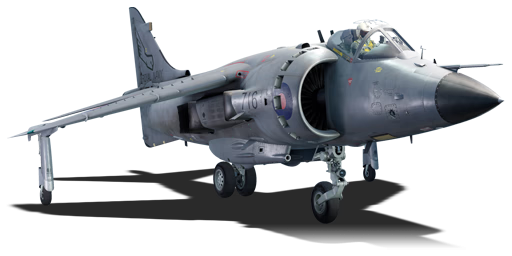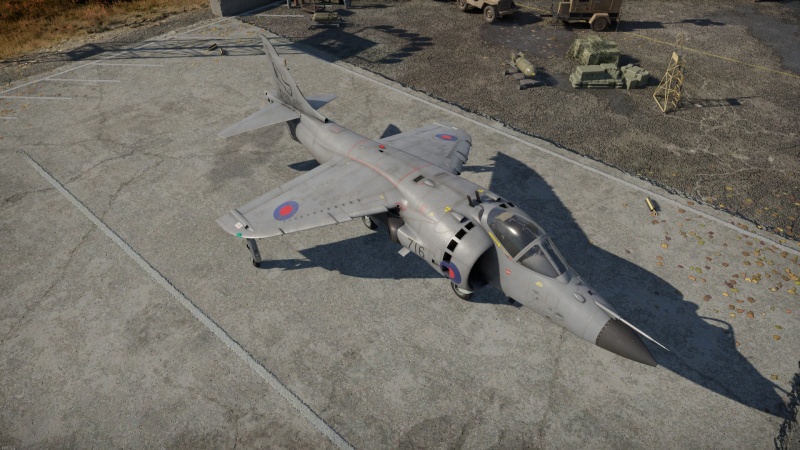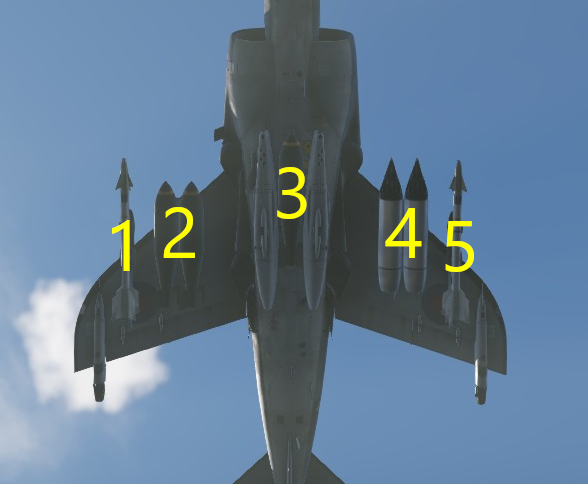Difference between revisions of "Sea Harrier FRS.1"
Woman_chaser (talk | contribs) (Working on page, first save.) (Tag: Visual edit) |
Colok76286 (talk | contribs) (Edits) |
||
| Line 13: | Line 13: | ||
The '''{{Specs|name}}''' is a squadron rank {{Specs|rank}} British strike aircraft {{Battle-rating}}. It was introduced in [[Update "Apex Predators"]]. | The '''{{Specs|name}}''' is a squadron rank {{Specs|rank}} British strike aircraft {{Battle-rating}}. It was introduced in [[Update "Apex Predators"]]. | ||
| − | The Sea Harrier FRS.1 was a navalised variant of the Hawker-Siddeley Harrier. Entering service with the United Kingdoms Royal navy in 1978, it went on to earn fame for its | + | The Sea Harrier FRS.1 was a navalised variant of the Hawker-Siddeley Harrier. Entering service with the United Kingdoms Royal navy in 1978, it went on to earn fame for its engagement during the Falklands conflict in 1982 against the Argentinian air forces. |
| − | The Sea Harrier is available as an option for rank VII through unlock as a squadron vehicle. It can present experienced pilots familiar with the GR.1/3 with a further improvement in the form of deadly AIM-9L sidewinder missiles and a unique position as the only model of harrier in-game with a search radar. Ultimately the Sea Harrier builds on the strengths of the Harrier GR.3 with improved air to air combat capability. However this comes at a cost of being heavier and slightly more sluggish than it's contemporaries. | + | The Sea Harrier is available as an option for rank VII through unlock as a squadron vehicle. It can present experienced pilots familiar with the GR.1/3 with a further improvement in the form of deadly AIM-9L sidewinder missiles and a unique position as the only model of harrier in-game with a search radar. Ultimately, the Sea Harrier builds on the strengths of the Harrier GR.3 with improved air-to-air combat capability. However this comes at a cost of being heavier and slightly more sluggish than it's contemporaries. |
| − | All | + | All in all, the Sea Harrier can be powerful opponent in the hands of a veteran pilot and provides an almost preparatory experience for the Harrier GR.7. |
== General info == | == General info == | ||
| Line 50: | Line 50: | ||
! Combat flaps !! Take-off flaps !! Landing flaps !! Air brakes !! Arrestor gear !! Drogue chute | ! Combat flaps !! Take-off flaps !! Landing flaps !! Air brakes !! Arrestor gear !! Drogue chute | ||
|- | |- | ||
| − | | X || ✓ || ✓ || ✓ || X || X <!-- ✓ --> | + | | X || ✓ || ✓ || ✓ || X || X <!-- ✓ --> |
|- | |- | ||
|} | |} | ||
| Line 95: | Line 95: | ||
|- | |- | ||
! Weight (each) || colspan="2" | Type | ! Weight (each) || colspan="2" | Type | ||
| − | ! 9m fuel || 20m fuel || 30m fuel | + | ! 9m fuel || 20m fuel || 30m fuel || 33m fuel |
| − | |||
|- | |- | ||
| 1,640 kg || colspan="2" | Vectored-thrust low-bypass turbofan | | 1,640 kg || colspan="2" | Vectored-thrust low-bypass turbofan | ||
| − | | _,___ kg || _,___ kg || _,___ kg | + | | _,___ kg || _,___ kg || _,___ kg || _,___ kg || _,___ kg |
| − | ||| _,___ kg | ||
|- | |- | ||
! colspan="3" | {{Annotation|Maximum engine thrust @ 0 m (RB/SB)|The maximum thrust produced by each engine, while mounted in the aircraft. NOTE: Thrust varies significantly depending on speed & altitude.}} | ! colspan="3" | {{Annotation|Maximum engine thrust @ 0 m (RB/SB)|The maximum thrust produced by each engine, while mounted in the aircraft. NOTE: Thrust varies significantly depending on speed & altitude.}} | ||
| Line 106: | Line 104: | ||
|- | |- | ||
! Condition || 100% || WEP | ! Condition || 100% || WEP | ||
| − | ! 9m fuel || 20m fuel || 30m fuel | + | ! 9m fuel || 20m fuel || 30m fuel || 33m fuel || MTOW |
| − | |||
|- | |- | ||
| ''Stationary'' || 9,150 kgf || 9710 kgf | | ''Stationary'' || 9,150 kgf || 9710 kgf | ||
| − | | _.__ || _.__ || _.__ | + | | _.__ || _.__ || _.__ || _.__ || _.__ |
| − | ||| _.__ | ||
|- | |- | ||
| ''Optimal'' || 9,150 kgf<br>(0 km/h) || 9710 kgf<br>(0 km/h) | | ''Optimal'' || 9,150 kgf<br>(0 km/h) || 9710 kgf<br>(0 km/h) | ||
| − | | _.__ || _.__ || _.__ | + | | _.__ || _.__ || _.__ || _.__ || _.__ |
| − | ||| _.__ | ||
|- | |- | ||
|} | |} | ||
=== Survivability and armour === | === Survivability and armour === | ||
| − | + | {{Specs-Avia-Armour}} | |
| + | <!-- ''Examine the survivability of the aircraft. Note how vulnerable the structure is and how secure the pilot is, whether the fuel tanks are armoured, etc. Describe the armour, if there is any, and also mention the vulnerability of other critical aircraft systems.'' --> | ||
| − | The | + | The Sea Harrier FRS.1 possesses no armour. All of its internal modules are arrayed in close proximity within the fuselage centred around the engine. |
| + | |||
| + | The Sea Harrier is not a sturdy aircraft and can be destroyed fairly easily owing to its compact assembly. However, if the damage taken is not enough to outright down the harrier such as damage to flaps or wings, the harrier can in an emergency leverage its thrust vectoring to compensate for lift lost from wing damage and limp back to the airfield for repair at the cost of being exceptionally vulnerable to enemy aircraft. | ||
=== Modifications and economy === | === Modifications and economy === | ||
Revision as of 10:02, 29 December 2022
| This page is about the squadron British strike aircraft Sea Harrier FRS.1. For other versions, see Harrier (Family). |
Contents
Description
The Sea Harrier FRS.1 is a squadron rank VII British strike aircraft with a battle rating of 11.3 (AB/SB) and 11.0 (RB). It was introduced in Update "Apex Predators".
The Sea Harrier FRS.1 was a navalised variant of the Hawker-Siddeley Harrier. Entering service with the United Kingdoms Royal navy in 1978, it went on to earn fame for its engagement during the Falklands conflict in 1982 against the Argentinian air forces.
The Sea Harrier is available as an option for rank VII through unlock as a squadron vehicle. It can present experienced pilots familiar with the GR.1/3 with a further improvement in the form of deadly AIM-9L sidewinder missiles and a unique position as the only model of harrier in-game with a search radar. Ultimately, the Sea Harrier builds on the strengths of the Harrier GR.3 with improved air-to-air combat capability. However this comes at a cost of being heavier and slightly more sluggish than it's contemporaries.
All in all, the Sea Harrier can be powerful opponent in the hands of a veteran pilot and provides an almost preparatory experience for the Harrier GR.7.
General info
Flight performance
Describe how the aircraft behaves in the air. Speed, manoeuvrability, acceleration and allowable loads - these are the most important characteristics of the vehicle.
| Characteristics | Max speed (km/h at 0 m - sea level) |
Max altitude (metres) |
Turn time (seconds) |
Rate of climb (metres/second) |
Take-off run (metres) | |||
|---|---|---|---|---|---|---|---|---|
| AB | RB | AB | RB | AB | RB | |||
| Stock | 1,150 | 1,144 | 12192 | 32.5 | 34.0 | 70.2 | 68.5 | 550 |
| Upgraded | ___ | ___ | __._ | __._ | __._ | __._ | ||
Details
| Features | |||||
|---|---|---|---|---|---|
| Combat flaps | Take-off flaps | Landing flaps | Air brakes | Arrestor gear | Drogue chute |
| X | ✓ | ✓ | ✓ | X | X |
| Limits | ||||||
|---|---|---|---|---|---|---|
| Wings (km/h) | Gear (km/h) | Flaps (km/h) | Max Static G | |||
| Combat | Take-off | Landing | + | - | ||
| 1191 | 648 | N/A | 880 | 633 | ~14 | ~6 |
| Optimal velocities (km/h) | |||
|---|---|---|---|
| Ailerons | Rudder | Elevators | Radiator |
| < ___ | < ___ | < ___ | N/A |
Engine performance
| Engine | Aircraft mass | ||||||
|---|---|---|---|---|---|---|---|
| Engine name | Number | Basic mass | Wing loading (full fuel) | ||||
| Rolls-Royce Pegasus Mk.103 | 1 | _,___ kg | ___ kg/m2 | ||||
| Engine characteristics | Mass with fuel (no weapons load) | Max Gross Weight | |||||
| Weight (each) | Type | 9m fuel | 20m fuel | 30m fuel | 33m fuel | ||
| 1,640 kg | Vectored-thrust low-bypass turbofan | _,___ kg | _,___ kg | _,___ kg | _,___ kg | _,___ kg | |
| Maximum engine thrust @ 0 m (RB/SB) | Thrust to weight ratio @ 0 m (___%/WEP) | ||||||
| Condition | 100% | WEP | 9m fuel | 20m fuel | 30m fuel | 33m fuel | MTOW |
| Stationary | 9,150 kgf | 9710 kgf | _.__ | _.__ | _.__ | _.__ | _.__ |
| Optimal | 9,150 kgf (0 km/h) |
9710 kgf (0 km/h) |
_.__ | _.__ | _.__ | _.__ | _.__ |
Survivability and armour
The Sea Harrier FRS.1 possesses no armour. All of its internal modules are arrayed in close proximity within the fuselage centred around the engine.
The Sea Harrier is not a sturdy aircraft and can be destroyed fairly easily owing to its compact assembly. However, if the damage taken is not enough to outright down the harrier such as damage to flaps or wings, the harrier can in an emergency leverage its thrust vectoring to compensate for lift lost from wing damage and limp back to the airfield for repair at the cost of being exceptionally vulnerable to enemy aircraft.
Modifications and economy
Armaments
| Ballistic Computer | |||
|---|---|---|---|
| CCIP (Guns) | CCIP (Rockets) | CCIP (Bombs) | CCRP (Bombs) |
| |
|
|
|
Offensive armament
The Sea Harrier FRS.1 is armed with:
- A choice between two presets:
- 2 x 30 mm ADEN Mk.4 cannons, belly-mounted (130 rpg = 260 total)
- 2 x 30 mm ADEN Mk.4 cannons + 60 x countermeasures
Suspended armament
The Sea Harrier FRS.1 can be outfitted with the following ordnance presets:
- Without load
- 2 x AIM-9G Sidewinder missiles
- 2 x AIM-9L Sidewinder missiles
- 4 x AIM-9L Sidewinder missiles
- 72 x RP rockets
- 3 x 1,000 lb H.E. M.C. Mk.13 bombs (3,000 lb total)
- 4 x 1,000 lb H.E. M.C. Mk.13 bombs (4,000 lb total)
- 5 x 1,000 lb H.E. M.C. Mk.13 bombs + 2 x AIM-9G Sidewinder missiles (5,000 lb total)
- 5 x 1,000 lb H.E. M.C. Mk.13 bombs + 4 x AIM-9L Sidewinder missiles (5,000 lb total)
- 2 x AIM-9G Sidewinder missiles + 72 x RP rockets
- 4 x AIM-9L Sidewinder missiles + 72 x RP rockets
Custom loadout options
| 1 | 2 | 3 | 4 | 5 | ||
|---|---|---|---|---|---|---|
| 1,000 lb H.E. M.C. Mk.13 bombs | 1, 2 | 1 | 1, 2 | |||
| RP rockets | 36 | 36 | ||||
| AIM-9G Sidewinder missiles | 1 | 1 | ||||
| AIM-9L Sidewinder missiles | 1, 2 | 1, 2 |
Usage in battles
Describe the tactics of playing in the aircraft, the features of using aircraft in a team and advice on tactics. Refrain from creating a "guide" - do not impose a single point of view, but instead, give the reader food for thought. Examine the most dangerous enemies and give recommendations on fighting them. If necessary, note the specifics of the game in different modes (AB, RB, SB).
Pros and cons
Summarise and briefly evaluate the vehicle in terms of its characteristics and combat effectiveness. Mark its pros and cons in the bulleted list. Try not to use more than 6 points for each of the characteristics. Avoid using categorical definitions such as "bad", "good" and the like - use substitutions with softer forms such as "inadequate" and "effective".
Pros:
Cons:
History
Describe the history of the creation and combat usage of the aircraft in more detail than in the introduction. If the historical reference turns out to be too long, take it to a separate article, taking a link to the article about the vehicle and adding a block "/History" (example: https://wiki.warthunder.com/(Vehicle-name)/History) and add a link to it here using the main template. Be sure to reference text and sources by using <ref></ref>, as well as adding them at the end of the article with <references />. This section may also include the vehicle's dev blog entry (if applicable) and the in-game encyclopedia description (under === In-game description ===, also if applicable).
Media
Excellent additions to the article would be video guides, screenshots from the game, and photos.
See also
Links to the articles on the War Thunder Wiki that you think will be useful for the reader, for example:
- reference to the series of the aircraft;
- links to approximate analogues of other nations and research trees.
External links
Paste links to sources and external resources, such as:
- topic on the official game forum;
- other literature.
| British Aerospace plc | |
|---|---|
| Strike Aircraft | Harrier GR.7 · Sea Harrier FRS.1 (e) · Sea Harrier FRS.1 · Sea Harrier FA 2 |
| See also | British Aircraft Corporation · Hawker Aircraft Limited |
| Britain jet aircraft | |
|---|---|
| Blackburn | Buccaneer S.1 · Buccaneer S.2 · Buccaneer S.2B |
| British Aerospace | Harrier GR.7 · Sea Harrier FRS.1 (e) · Sea Harrier FRS.1 · Sea Harrier FA 2 |
| British Aircraft Corporation | Strikemaster Mk.88 |
| English Electric | Canberra B Mk 2 · Canberra B (I) Mk 6 · Lightning F.6 · Lightning F.53 |
| Gloster | Meteor F Mk 3 · Sea Meteor F Mk 3 · Meteor F Mk 4 G.41F · Meteor F Mk 4 G.41G · Meteor F Mk 8 G.41K · Meteor F Mk.8 Reaper |
| Javelin F.(A.W.) Mk.9 | |
| de Havilland | Vampire F.B.5 · Venom FB.4 · Sea Venom FAW 20 · Sea Vixen F.A.W. Mk.2 |
| Hawker | Sea Hawk FGA.6 · Hunter F.1 · Hunter F.6 · Hunter FGA.9 · Harrier GR.1 · Harrier GR.3 |
| Panavia | Tornado GR.1 · Tornado GR.4 · Tornado F.3 · Tornado F.3 Late |
| SEPECAT | Jaguar GR.1 · Jaguar GR.1A · Jaguar IS |
| Supermarine | Attacker FB 1 · Attacker FB.2 · Scimitar F Mk.1 · Swift F.1 · Swift F.7 |
| Foreign | Phantom FG.1 (USA) · Phantom FGR.2 (USA) · F-4J(UK) Phantom II (USA) |
| Australia | F-111C |
| India | ▄MiG-21 Bison |
| South Africa | ▄JAS39C |
| Squadron aircraft | |
|---|---|
| USA | A-4E Early · F-117 |
| Germany | Me 262 A-1a/U1 · ◌Hunter F.58 |
| USSR | Su-22M3 |
| Britain | Firecrest · Sea Harrier FRS.1 |
| Japan | ▄F-5E FCU |
| China | JF-17 |






